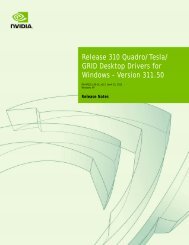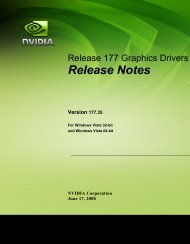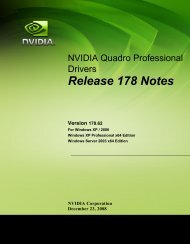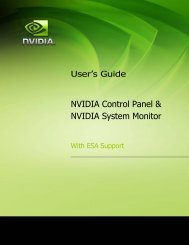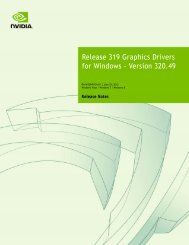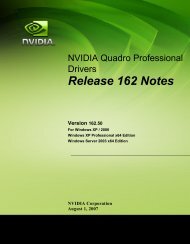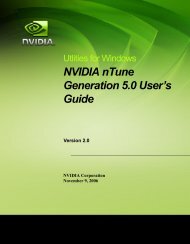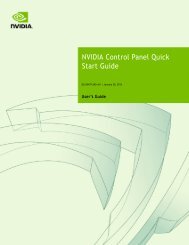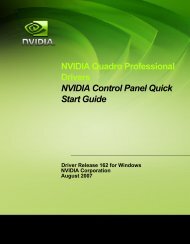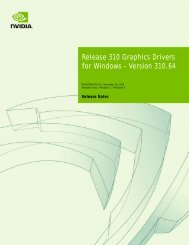Release 295 Quadro & NVS Notebook Drivers for Windows ... - Nvidia
Release 295 Quadro & NVS Notebook Drivers for Windows ... - Nvidia
Release 295 Quadro & NVS Notebook Drivers for Windows ... - Nvidia
Create successful ePaper yourself
Turn your PDF publications into a flip-book with our unique Google optimized e-Paper software.
<strong>Release</strong> <strong>295</strong> <strong>Quadro</strong> & <strong>NVS</strong><br />
<strong>Notebook</strong> <strong>Drivers</strong> <strong>for</strong><br />
<strong>Windows</strong> - Version 296.88<br />
RN-WQ29688-01n_v02 |June 12, 2012<br />
<strong>Windows</strong> 7, <strong>Windows</strong> Vista<br />
<strong>Release</strong> Notes
TABLE OF CONTENTS<br />
1 Introduction to <strong>Release</strong> Notes .................................................. 1<br />
Structure of the Document ........................................................ 1<br />
Changes in this Edition ............................................................. 1<br />
2 <strong>Release</strong> <strong>295</strong> Driver Changes..................................................... 2<br />
Version 296.88 Highlights .......................................................... 3<br />
Existing Support.................................................................. 3<br />
What’s New in <strong>Release</strong> <strong>295</strong>..................................................... 3<br />
What’s New in Version 296.88 ................................................. 4<br />
Discontinued Features in this <strong>Release</strong> ........................................ 4<br />
Limitations in This <strong>Release</strong> ..................................................... 6<br />
Advanced Instructions <strong>for</strong> this <strong>Release</strong> .......................................... 7<br />
Turning Off V-Sync to Boost Per<strong>for</strong>mance .................................... 8<br />
NVIDIA Application Configuration Engine (ACE) ............................. 8<br />
Changes in Version 296.88 ......................................................... 1<br />
Changes in Version 296.70 ......................................................... 1<br />
Changes in Version 296.35 ......................................................... 2<br />
Open Issues in Version 296.88..................................................... 3<br />
<strong>Windows</strong> Vista/<strong>Windows</strong> 7 32-bit Issues...................................... 3<br />
<strong>Windows</strong> Vista/<strong>Windows</strong> 7 64-bit Issues...................................... 3<br />
Not NVIDIA Issues.................................................................... 4<br />
<strong>Windows</strong> Vista Considerations ................................................. 4<br />
<strong>Windows</strong> 7 Considerations...................................................... 4<br />
Unsupported Features........................................................... 5<br />
OpenGL Application Issues ..................................................... 7<br />
Application Issues................................................................ 7<br />
Other Issues....................................................................... 7<br />
Known Product Limitations ........................................................ 9<br />
Some APIs do not Report Total Available Graphics Memory Correctly ... 9<br />
Using HDMI/DisplayPort Audio with Displays that have a High Native<br />
Resolution........................................................................ 10<br />
Using HDMI/DisplayPort Displays that do not Support Audio............. 12<br />
Using HDMI/DisplayPort Audio in Dualview or Clone Mode Configurations13<br />
GPU Runs at a High Per<strong>for</strong>mance Level (full clock speeds) in Multi-display<br />
<strong>Release</strong> <strong>295</strong> <strong>Quadro</strong> & <strong>NVS</strong> <strong>Notebook</strong> <strong>Drivers</strong> <strong>for</strong> <strong>Windows</strong> - Version 296.88 RN-WQ29688-01n_v02 | i
TABLE OF CONTENTS<br />
Modes ............................................................................ 13<br />
Aero Must be Enabled <strong>for</strong> Windowed SLI AFR Mode Under Vista ........ 13<br />
SLI Connector Requirement on NVIDIA <strong>Quadro</strong> SLI Cards ................. 13<br />
Applying Workstation Application Profiles .................................. 14<br />
1280x1024 @ 60 Hz not Available on BenQ FP241W Monitors ............ 14<br />
Gigabyte GA-6BX Motherboard ............................................... 14<br />
3 The <strong>Release</strong> <strong>295</strong> Driver .........................................................15<br />
Hardware and Software Support................................................. 15<br />
Supported Operating Systems................................................. 15<br />
Supported NVIDIA <strong>Notebook</strong> Products....................................... 16<br />
Supported Languages........................................................... 18<br />
Driver Installation.................................................................. 19<br />
Minimum Hard Disk Space ..................................................... 19<br />
Be<strong>for</strong>e You Begin ................................................................ 19<br />
Installation Instructions........................................................ 19<br />
Appendix A: Mode Support <strong>for</strong> <strong>Windows</strong> .......................................21<br />
General Mode Support In<strong>for</strong>mation.............................................. 22<br />
Understanding the Mode Format ............................................. 23<br />
<strong>Quadro</strong> <strong>Notebook</strong> GPUs ........................................................ 24<br />
Modes Supported by TV Encoders ............................................... 26<br />
<strong>Release</strong> <strong>295</strong> <strong>Quadro</strong> & <strong>NVS</strong> <strong>Notebook</strong> <strong>Drivers</strong> <strong>for</strong> <strong>Windows</strong> - Version 296.88 RN-WQ29688-01n_v02 | ii
LIST OF TABLES<br />
Table 3.1 Supported NVIDIA <strong>NVS</strong> and <strong>Quadro</strong> <strong>NVS</strong> M GPUs .............................. 16<br />
Table 3.2 Supported NVIDIA <strong>Quadro</strong> M and <strong>Quadro</strong> FX M GPUs ........................ 17<br />
Table A.1 Modes Supported <strong>for</strong> High Resolution Displays ............................... 22<br />
Table A.2 Non-standard Modes Supported................................................. 22<br />
Table A.3 Mode Support <strong>for</strong> S-Video and Composite Out................................ 26<br />
Table A.4 Mode Support <strong>for</strong> Component YPrPb Out and DVI Out....................... 26<br />
<strong>Release</strong> <strong>295</strong> <strong>Quadro</strong> & <strong>NVS</strong> <strong>Notebook</strong> <strong>Drivers</strong> <strong>for</strong> <strong>Windows</strong> - Version 296.88 RN-WQ29688-01n_v02 | iii
01 INTRODUCTION TO RELEASE NOTES<br />
This edition of <strong>Release</strong> Notes describes the <strong>Release</strong> <strong>295</strong> family of NVIDIA <strong>Quadro</strong> and<br />
<strong>NVS</strong> <strong>Notebook</strong> <strong>Drivers</strong> <strong>for</strong> Microsoft ® <strong>Windows</strong> ® Vista/<strong>Windows</strong> 7. NVIDIA provides<br />
these notes to describe per<strong>for</strong>mance improvements and bug fixes in each documented<br />
version of the driver.<br />
Structure of the Document<br />
This document is organized in the following sections:<br />
� “<strong>Release</strong> <strong>295</strong> Driver Changes” on page 2 gives a summary of changes, and fixed and<br />
open issues in this version.<br />
� “The <strong>Release</strong> <strong>295</strong> Driver” on page 15 describes the NVIDIA products and languages<br />
supported by this driver, the system requirements, and how to install the driver.<br />
� “Mode Support <strong>for</strong> <strong>Windows</strong>” on page 21 lists the default resolutions supported by<br />
the driver.<br />
Changes in this Edition<br />
This edition of the <strong>Release</strong> Notes <strong>for</strong> <strong>Windows</strong> Vista/<strong>Windows</strong> 7 includes in<strong>for</strong>mation<br />
about NVIDIA graphics driver version 296.88, and lists changes made to the driver since<br />
version 290.37 and 276.52. These changes are discussed beginning with the chapter<br />
“<strong>Release</strong> <strong>295</strong> Driver Changes” on page 2.<br />
<strong>Release</strong> <strong>295</strong> <strong>Quadro</strong> & <strong>NVS</strong> <strong>Notebook</strong> <strong>Drivers</strong> <strong>for</strong> <strong>Windows</strong> - Version 296.88 RN-WQ29688-01n_v02 | 1
02 RELEASE <strong>295</strong> DRIVER CHANGES<br />
This chapter describes open issues <strong>for</strong> version 296.88, and resolved issues and driver<br />
enhancements <strong>for</strong> versions of the <strong>Release</strong> <strong>295</strong> driver up to version 296.88. The chapter<br />
contains these sections:<br />
� “Version 296.88 Highlights” on page 3<br />
� “Advanced Instructions <strong>for</strong> this <strong>Release</strong>” on page 7<br />
� “Changes in Version 296.88” on page 1<br />
� “Changes in Version 296.70” on page 1<br />
� “Changes in Version 296.35” on page 2<br />
� “Open Issues in Version 296.88” on page 3<br />
� “Not NVIDIA Issues” on page 4<br />
� “Known Product Limitations” on page 9<br />
<strong>Release</strong> <strong>295</strong> <strong>Quadro</strong> & <strong>NVS</strong> <strong>Notebook</strong> <strong>Drivers</strong> <strong>for</strong> <strong>Windows</strong> - Version 296.88 RN-WQ29688-01n_v02 | 2
Version 296.88 Highlights<br />
Chapter 02 : RELEASE <strong>295</strong> DRIVER CHANGES<br />
This section provides highlights of version 296.88 of the NVIDIA <strong>Release</strong> <strong>295</strong> Driver <strong>for</strong><br />
<strong>Windows</strong> Vista/<strong>Windows</strong> 7.<br />
� Existing Support<br />
� What’s New in <strong>Release</strong> <strong>295</strong><br />
� What’s New in Version 296.88<br />
� Discontinued Features in this <strong>Release</strong><br />
� Limitations in This <strong>Release</strong><br />
Existing Support<br />
This release supports the following APIs:<br />
� Open Computing Language (OpenCL) 1.1 in <strong>Quadro</strong> FX Series x700 .<br />
� OpenGL 4.2<br />
� DirectX 11<br />
� CUDA 4.1<br />
What’s New in <strong>Release</strong> <strong>295</strong><br />
The section summarizes the following driver changes in <strong>Release</strong> <strong>295</strong> since <strong>Release</strong> 275:<br />
ODE Driver<br />
The R<strong>295</strong> drivers are the second ʹOptimal <strong>Drivers</strong> <strong>for</strong> Enterpriseʹ, a release dedicated to<br />
relatively long term stability <strong>for</strong> ISV certification, OEMs, and Enterprise customers.<br />
Product Support<br />
� Added support <strong>for</strong> <strong>Notebook</strong> Workstation public OEM systems.<br />
Includes all OEM plat<strong>for</strong>m customizations in the driver existing at the products’<br />
launch.<br />
NVIDIA Control Panel<br />
Manage 3D Settings - Profile Notification<br />
� Added the Preferences tab which lets the user control the application profile<br />
notification feature.<br />
Upon launch of a windowed 3D program, this feature causes a popup to appear<br />
notifying the user which workstation application profile was applied.<br />
<strong>Release</strong> <strong>295</strong> <strong>Quadro</strong> & <strong>NVS</strong> <strong>Notebook</strong> <strong>Drivers</strong> <strong>for</strong> <strong>Windows</strong> - Version 296.88 RN-WQ29688-01n_v02 | 3
Adjust Desktop Color Settings page<br />
Chapter 02 : RELEASE <strong>295</strong> DRIVER CHANGES<br />
� Color settings are now preserved across system reboots, logins, and fast user<br />
switching <strong>for</strong> GPU/displays that support HDMI infoframes.<br />
Set Up Multiple Displays page<br />
� Slight change in the menu process <strong>for</strong> setting up Clone mode–displays are now added<br />
to a ‘Clone group’.<br />
OpenGL<br />
� Added support <strong>for</strong> OpenGL 4.2<br />
CUDA<br />
� Added support <strong>for</strong> CUDA 4.1 toolkit<br />
OpenCL<br />
Added support <strong>for</strong> the Open Computing Language (OpenCL) 1.1 in <strong>Quadro</strong> FX Series<br />
x700 and newer.<br />
256GB Virtual Space<br />
� OpenGL and CUDA users can now take full advantage of applications that utilize<br />
256GB of system memory<br />
What’s New in Version 296.88<br />
� Added support <strong>for</strong> the following products:<br />
• <strong>Quadro</strong> 410<br />
• <strong>NVS</strong> 310<br />
� This driver offers per<strong>for</strong>mance improvements over previous driver versions,<br />
including workstation compatibility fixes.<br />
� See “Changes in Version 296.88” on page 1 <strong>for</strong> a list of changes and resolved issues in<br />
this driver version.<br />
Discontinued Features in this <strong>Release</strong><br />
� The NVIDIA® AutoCAD Per<strong>for</strong>mance driver is no longer integrated in the graphics<br />
driver.<br />
Standalone versions or version updates can still be downloaded from the NVIDIA<br />
driver download page.<br />
� The following features are removed from the NVIDIA Control Panel<br />
<strong>Release</strong> <strong>295</strong> <strong>Quadro</strong> & <strong>NVS</strong> <strong>Notebook</strong> <strong>Drivers</strong> <strong>for</strong> <strong>Windows</strong> - Version 296.88 RN-WQ29688-01n_v02 | 4
Chapter 02 : RELEASE <strong>295</strong> DRIVER CHANGES<br />
• The Views option<br />
You no longer need to select between Standard and Advanced views <strong>for</strong> many<br />
NVIDIA Control Panel controls.<br />
• The Profiles menu<br />
<strong>Release</strong> <strong>295</strong> <strong>Quadro</strong> & <strong>NVS</strong> <strong>Notebook</strong> <strong>Drivers</strong> <strong>for</strong> <strong>Windows</strong> - Version 296.88 RN-WQ29688-01n_v02 | 5
Limitations in This <strong>Release</strong><br />
Chapter 02 : RELEASE <strong>295</strong> DRIVER CHANGES<br />
The following are features that are not currently supported or have limited support in<br />
this driver release:<br />
� NvCPL API Support<br />
The NvCPL API support is discontinued <strong>for</strong> <strong>Windows</strong> 7 and later. Customers are<br />
advised to switch to NVAPI.<br />
� Video Memory Support<br />
For <strong>Windows</strong> 7 and <strong>Windows</strong> Vista 64‐bit, this driver recognizes up to the total<br />
available video memory on <strong>Quadro</strong> cards <strong>for</strong> Direct3D and OpenGL applications.<br />
For <strong>Windows</strong> 7 and <strong>Windows</strong> Vista 32‐bit, this driver recognizes only up to 4 GB of<br />
video memory on <strong>Quadro</strong> cards <strong>for</strong> DirectX, OpenGL, and CUDA applications.<br />
� NVIDIA Control Panel Display Category<br />
• The Graph tab on the Adjust Desktop Color Settings page is not available.<br />
<strong>Release</strong> <strong>295</strong> <strong>Quadro</strong> & <strong>NVS</strong> <strong>Notebook</strong> <strong>Drivers</strong> <strong>for</strong> <strong>Windows</strong> - Version 296.88 RN-WQ29688-01n_v02 | 6
Advanced Instructions <strong>for</strong> this <strong>Release</strong><br />
Chapter 02 : RELEASE <strong>295</strong> DRIVER CHANGES<br />
This section clarifies instructions <strong>for</strong> successfully accomplishing the following tasks:<br />
� Turning Off V‐Sync to Boost Per<strong>for</strong>mance<br />
� NVIDIA Application Configuration Engine (ACE)<br />
<strong>Release</strong> <strong>295</strong> <strong>Quadro</strong> & <strong>NVS</strong> <strong>Notebook</strong> <strong>Drivers</strong> <strong>for</strong> <strong>Windows</strong> - Version 296.88 RN-WQ29688-01n_v02 | 7
Turning Off V-Sync to Boost Per<strong>for</strong>mance<br />
Chapter 02 : RELEASE <strong>295</strong> DRIVER CHANGES<br />
To get the best benchmark and application per<strong>for</strong>mance measurements, turn V‐Sync off<br />
as follows:<br />
1 Open the NVIDIA Control Panel and make sure that Advanced Settings is selected from<br />
the control panel tool bar.<br />
2 From the Select a Task pane, under 3D Settings, click Manage 3D Settings, then click<br />
the Global Settings tab.<br />
3 From the Global presets pull‐down menu, select Base profile.<br />
4 From the Settings list box, select Vertical sync and change its value to Force off, then<br />
click Apply.<br />
5 From the Global presets pull‐down menu, select 3D App ‐ Default Global Settings<br />
(the driver’s default profile) or use the application profile that matches the application<br />
you are testing, then click Apply.<br />
Be sure to close the NVIDIA Control Panel completely —leaving it open will affect<br />
benchmark and application per<strong>for</strong>mance.<br />
NVIDIA Application Configuration Engine (ACE)<br />
This driver includes the NVIDIA Application Configuration Engine (ACE), which<br />
automatically detects the workstation application and configures the appropriate profile<br />
settings in the NVIDIA Control Panel.<br />
See the NVIDIA <strong>Quadro</strong> Professional <strong>Drivers</strong>: NVIDIA Control Panel Quick Start Guide <strong>for</strong><br />
more in<strong>for</strong>mation about this feature.<br />
<strong>Release</strong> <strong>295</strong> <strong>Quadro</strong> & <strong>NVS</strong> <strong>Notebook</strong> <strong>Drivers</strong> <strong>for</strong> <strong>Windows</strong> - Version 296.88 RN-WQ29688-01n_v02 | 8
Changes in Version 296.88<br />
Changes in Version 296.88<br />
The following sections list the important changes and the most common issues resolved<br />
since driver version 296.70.<br />
� Cinema 4D: The driver crashes during glDrawElements while running the<br />
application. [981669]<br />
� Stereoscopic 3D Apps: Black borders appear on one stereo eye, or both eyes if<br />
“Always run in Stereo mode” is set.<br />
� Avid Studio 2: With 3D Discovery mode set from the NVIDIA Control Panel, the<br />
display has a red tint.<br />
� <strong>Quadro</strong> 6000: Scale clients hang when trying to join NV_swapgroup in Mosaic.<br />
� <strong>Quadro</strong> 2000/4000/5000: Data errors occur when loading the LUT.<br />
� <strong>Quadro</strong> 5000/FX 4800, Avid MediaComposer: The application loses swap‐sync,<br />
resulting in on‐screen tearing and degraded per<strong>for</strong>mance.<br />
� <strong>Quadro</strong> FX 1800. Revit 2013: Semi‐transparent material appears over elements when<br />
the material is positioned behind those elements.<br />
<strong>Release</strong> <strong>295</strong> <strong>Quadro</strong> & <strong>NVS</strong> <strong>Notebook</strong> <strong>Drivers</strong> <strong>for</strong> <strong>Windows</strong> - Version 296.88 RN-WQ29688-01n_v02 | 1
Changes in Version 296.70<br />
Changes in Version 296.70<br />
The following sections list the important changes and the most common issues resolved<br />
since driver version 296.35.<br />
� Allplan 2013: Application profile added to the NVIDIA Control Panel.<br />
� <strong>Quadro</strong> 6000, TouchDesigner: When calling glReadPixels() with a floating point<br />
datatype, the float values are clamped.<br />
� <strong>Quadro</strong> 2000: Opticore Visualizer 2010–Display driver stops working.<br />
� <strong>Quadro</strong> FX 4000: Opticore Visualizer–the application slows or lags when the camera<br />
gets close to the model.<br />
� <strong>Quadro</strong> FX 500, NX: Two‐sided light is not applied when rendering to the front buffer.<br />
� <strong>Quadro</strong> 1000M, MicroStation V8i: Drawing problem occurs during deferred lighting.<br />
<strong>Release</strong> <strong>295</strong> <strong>Quadro</strong> & <strong>NVS</strong> <strong>Notebook</strong> <strong>Drivers</strong> <strong>for</strong> <strong>Windows</strong> - Version 296.88 RN-WQ29688-01n_v02 | 1
Changes in Version 296.35<br />
Changes in Version 296.35<br />
The following sections list the important changes and the most common issues resolved<br />
since driver version <strong>295</strong>.73.<br />
� NX6–the application exits at model load.<br />
� VideoLiteTest – the application stuters when the decoder calls<br />
IDirectXVideoDecoderService::CreateVideoDecoder on the GPU.<br />
� <strong>Quadro</strong> 5000: Creo View–’memcpy’ exception occurs when loading ECAD design<br />
data into the application.<br />
� <strong>Quadro</strong> 4000/FX 1800M: glLineWidth in OpenGL 3.2 core context fails.<br />
� <strong>Quadro</strong> 1000M: NX–notes aren’t highlighted when moving the cursor over them.<br />
� PTC ProE5–the application crashes.<br />
� <strong>Quadro</strong> 2000M: Optimus technology does not work properly with <strong>Quadro</strong> 2000M<br />
<strong>Release</strong> <strong>295</strong> <strong>Quadro</strong> & <strong>NVS</strong> <strong>Notebook</strong> <strong>Drivers</strong> <strong>for</strong> <strong>Windows</strong> - Version 296.88 RN-WQ29688-01n_v02 | 2
Open Issues in Version 296.88<br />
Open Issues in Version 296.88<br />
As with every released driver, version 296.88 of the <strong>Release</strong> <strong>295</strong> driver has open issues<br />
and enhancement requests associated with it. This section includes lists of issues that are<br />
either not fixed or not implemented in this version. Some problems listed may not have<br />
been thoroughly investigated and, in fact, may not be NVIDIA issues. Others may have<br />
workaround solutions.<br />
� “<strong>Windows</strong> Vista/<strong>Windows</strong> 7 32‐bit Issues” on page 3<br />
� “<strong>Windows</strong> Vista/<strong>Windows</strong> 7 64‐bit Issues” on page 3<br />
<strong>Windows</strong> Vista/<strong>Windows</strong> 7 32-bit Issues<br />
� Reduced per<strong>for</strong>mance is experienced with <strong>Release</strong> <strong>295</strong> drivers compared to the<br />
previous driver release.<br />
� <strong>Quadro</strong> FX 4600, HyperMesh: The application panel window (within the standalone<br />
application or the desktop client) comes up blank or crashes.<br />
� <strong>Quadro</strong> 6000/FX 5800, RTT DeltaGen: The application crashes when CUDA is<br />
switched off.<br />
� <strong>Quadro</strong> FX 880M, HP EliteBook 8540w notebook: Blue‐screen crash 0x116 or 0x124<br />
occurs after installing the driver and rebooting the system.<br />
<strong>Windows</strong> Vista/<strong>Windows</strong> 7 64-bit Issues<br />
� Reduced per<strong>for</strong>mance is experienced with <strong>Release</strong> <strong>295</strong> drivers compared to the<br />
previous driver release.<br />
� MicroStation (DirectX 11)– ‘Driver not responding’ errors occur.<br />
� <strong>Quadro</strong> 6000, Tesla C2070, RTT Deltagen: GPU raytracer hangs when switching the<br />
Tesla C2075 to ECC mode.<br />
� <strong>Quadro</strong> 6000, Lenovo D30: The driver stops working while some applications are<br />
running.<br />
� <strong>Quadro</strong> 4000, DecisionSpace Desktop: The application exits with a “Driver not<br />
responding” message indicating NVIDIA ʺerror code 8ʺ.<br />
� <strong>Quadro</strong> 2000: SIEMENS FEMAP : Window compositer issues occur within Femap.<br />
� <strong>Quadro</strong> FX 3700, 3D Vision, RemoteView 3.2.2: The Roam operation is not smooth.<br />
� <strong>Quadro</strong> FX 580, Creo View: During a compare operation, an NVIDIA OpenGL error<br />
message appears pointing to P‐buffer glReadPixels calls.<br />
<strong>Release</strong> <strong>295</strong> <strong>Quadro</strong> & <strong>NVS</strong> <strong>Notebook</strong> <strong>Drivers</strong> <strong>for</strong> <strong>Windows</strong> - Version 296.88 RN-WQ29688-01n_v02 | 3
Not NVIDIA Issues<br />
Not NVIDIA Issues<br />
This section lists issues that are not due to the NVIDIA driver as well as features that are<br />
not meant to be supported by the NVIDIA driver <strong>for</strong> <strong>Windows</strong> Vista/<strong>Windows</strong> 7.<br />
� “<strong>Windows</strong> Vista Considerations” on page 4<br />
� “<strong>Windows</strong> 7 Considerations” on page 4<br />
� “Unsupported Features” on page 5<br />
� “OpenGL Application Issues” on page 7<br />
� “OpenGL Application Issues” on page 7<br />
� “Application Issues” on page 7<br />
� “Other Issues” on page 7<br />
<strong>Windows</strong> Vista Considerations<br />
These are behaviors that may be different from <strong>Windows</strong> XP and are related directly to<br />
the <strong>Windows</strong> Vista operating system.<br />
� Gamma ramps are inconsistent between single and two‐headed systems.<br />
� NVIDIA TurboCache<br />
<strong>Windows</strong> Vista now controls the allocation of system memory to the GPU <strong>for</strong><br />
TurboCache functions. The <strong>Windows</strong> Vista Display Properties pages show the shared<br />
system memory (SSM), or how much memory is allocated <strong>for</strong> NVIDIA GPUs to use<br />
<strong>for</strong> TurboCache.<br />
For more in<strong>for</strong>mation on graphics memory reporting under <strong>Windows</strong> Vista, visit<br />
http://www.microsoft.com/whdc/device/display/graphicsmemory.mspx.<br />
<strong>Windows</strong> 7 Considerations<br />
<strong>Windows</strong> DWM Disabled <strong>for</strong> SLI Mosaic Mode<br />
Due to compatibility issues, when using SLI Mosaic mode the driver turns off the<br />
<strong>Windows</strong> 7 Desktop Window Manager (DWM). As a result, DWM‐managed desktop<br />
features such as <strong>Windows</strong> Aero or <strong>Windows</strong> Flip 3D will not be available.<br />
Hotplug Action<br />
Unlike the hotplug activity under <strong>Windows</strong> Vista, the default settings are not applied<br />
when a new display is hotplugged, and there is no message balloon alert stating that a<br />
new display was detected. Under <strong>Windows</strong> 7, all display connection and detection<br />
events are handled through the <strong>Windows</strong> 7 Connecting and Configuring Displays (CCD)<br />
mechanism.<br />
<strong>Release</strong> <strong>295</strong> <strong>Quadro</strong> & <strong>NVS</strong> <strong>Notebook</strong> <strong>Drivers</strong> <strong>for</strong> <strong>Windows</strong> - Version 296.88 RN-WQ29688-01n_v02 | 4
NVIDIA Control Panel Rotate Display Page<br />
Not NVIDIA Issues<br />
The rotation radio button labels are changed slightly under <strong>Windows</strong> 7 to be consistent<br />
with the Microsoft panel<br />
Table 2.1 NVIDIA Control Panel Rotation Page Radio Buttons<br />
Clockwise<br />
Rotation<br />
Limitation<br />
� When switching the refresh rate from 59 Hz to 60Hz, the refresh rate remains at 59 Hz.<br />
See the Microsoft KB article KB2006076 at http://support.microsoft.com/kb/2006076.<br />
Unsupported Features<br />
The following are features and functionality that were available in driver releases<br />
supporting <strong>Windows</strong> XP, but are not–and will not be–available in driver releases <strong>for</strong><br />
<strong>Windows</strong> Vista:<br />
� High resolution scaling desktop (HRSD)<br />
� MultiView Display Mode (<strong>for</strong> NVIDIA <strong>Quadro</strong> <strong>NVS</strong> graphics cards)<br />
� NVKeystone<br />
� Unified back buffer (UBB) controls<br />
� OpenGL Video Overlays<br />
This is an operating system limitation.<br />
� Overclocking<br />
GPU overclocking is no longer supported in the default GPU driver control panel. This<br />
feature is available in the NVIDIA System Tools software, which you can download<br />
from NVIDIA.com.<br />
� GPU Temperature Monitoring<br />
Temperature monitoring is no longer supported in the default GPU driver control<br />
panel. This feature is available in the NVIDIA System Tools software, which you can<br />
download from NVIDIA.com.<br />
� AGP Settings Adjustment<br />
<strong>Windows</strong> 7 Label <strong>Windows</strong> Vista Label<br />
0 degrees Landscape No rotation (Landscape)<br />
90 degrees Portrait 90 degrees to the right (Inverted<br />
Portrait)<br />
180 degrees Landscape (flipped) 180 degree rotation (Inverted<br />
landscape)<br />
270 degrees Portrait (flipped) 90 degrees to the left (Portrait)<br />
<strong>Release</strong> <strong>295</strong> <strong>Quadro</strong> & <strong>NVS</strong> <strong>Notebook</strong> <strong>Drivers</strong> <strong>for</strong> <strong>Windows</strong> - Version 296.88 RN-WQ29688-01n_v02 | 5
� Video Zoom<br />
Not NVIDIA Issues<br />
� Pan & Scan ‐ the process of panning across the desktop in order to display a desktop<br />
on a monitor with lower resolution<br />
� Per‐display Desktop Color Setting Adjustments<br />
For Clone mode, the desktop color setting adjustments through the NVIDIA Control<br />
Panel can only be made across all displays in a system, and not on a per‐display basis.<br />
� Per‐display Video Color Setting Adjustments<br />
For Dualview mode, the video color setting adjustments through the NVIDIA Control<br />
Panel can only be made across all displays in a system, and not on a per‐display basis.<br />
� Edge Blending<br />
� Run display optimization wizard<br />
� Run multiple display wizard<br />
� Run television setup wizard<br />
� nView Horizontal and Vertical Span Modes<br />
Due to architectural changes in the new <strong>Windows</strong> Vista Window Display Driver<br />
Model (WDDM), span mode is available only with NVIDIA Mosaic Technology.<br />
� Display/Connection Wizard (such as was provided with <strong>Windows</strong> Media Center<br />
Edition)<br />
� DVD/MPEG Extensions (such as was provided with <strong>Windows</strong> Media Center Edition)<br />
� Audio Extensions (such as was provided with <strong>Windows</strong> Media Center Edition)<br />
<strong>Release</strong> <strong>295</strong> <strong>Quadro</strong> & <strong>NVS</strong> <strong>Notebook</strong> <strong>Drivers</strong> <strong>for</strong> <strong>Windows</strong> - Version 296.88 RN-WQ29688-01n_v02 | 6
OpenGL Application Issues<br />
Not NVIDIA Issues<br />
The following are known compatibility issues <strong>for</strong> OpenGL applications developed under<br />
<strong>Windows</strong> XP:<br />
� Mixed GDI and OpenGL rendering does not work.<br />
A number of applications use GDI to render UI components and object highlighting.<br />
This is not supported in the <strong>Windows</strong> Vista driver model.<br />
NVIDIA recommends converting GDI rendering to OpenGL.<br />
The following are some applications that are known to have this issue:<br />
• Maya 7.01<br />
� Applications, Tools, and Benchmarks not Supported Under <strong>Windows</strong> Vista<br />
• GLperf<br />
• 3ds max 8 (later releases may be supported)<br />
• CATIA V5R15 (V5R16 is supported)<br />
• PTC’s CDRS 2001<br />
� Front buffered rendering may be slow, especially when DWM is enabled.<br />
Flushing the rendering queue while rendering to the front buffer may cause the<br />
window manager to recomposite. Applications should there<strong>for</strong>e minimize the<br />
frequency with which they flush the rendering queue.<br />
Application Issues<br />
� Softimage–The application crashes when thumbing the CgFX scene model while in<br />
wireframe display mode.<br />
� Solidworks 2009–Application profile is not shown in the NVIDIA Control Panel when<br />
SolidWorks 2009 is installed.<br />
This is an issue with the application shortcut.<br />
� ArchiCAD–the driver crashes when navigating 3D shadows.<br />
� ArchiCAD12–OpenGL speed is half as fast on <strong>Windows</strong> Vista than on <strong>Windows</strong> XP.<br />
� CATIA V5R20–not all drawing elements appear if the drawing is created using<br />
Approximate mode.<br />
Other Issues<br />
� All older drivers from other vendors must be uninstalled first.<br />
� The <strong>Windows</strong> Vista display mode switches from Aeroglass to Basic when a quad‐<br />
buffer <strong>for</strong> stereo is created.<br />
� Quad‐buffered windowed stereo is only supported with Aeroglass turned off.<br />
<strong>Release</strong> <strong>295</strong> <strong>Quadro</strong> & <strong>NVS</strong> <strong>Notebook</strong> <strong>Drivers</strong> <strong>for</strong> <strong>Windows</strong> - Version 296.88 RN-WQ29688-01n_v02 | 7
Not NVIDIA Issues<br />
� The NVIDIA Control Panel‐>Set Up Multiple Displays page does not provide the<br />
capability of setting the dual monitor order under WIndows Vista as it does under<br />
<strong>Windows</strong> XP.<br />
This capability is provided through the <strong>Windows</strong> Vista Display Properties Settings page.<br />
<strong>Release</strong> <strong>295</strong> <strong>Quadro</strong> & <strong>NVS</strong> <strong>Notebook</strong> <strong>Drivers</strong> <strong>for</strong> <strong>Windows</strong> - Version 296.88 RN-WQ29688-01n_v02 | 8
Known Product Limitations<br />
This section describes problems that will not be fixed. Usually, the source of the problem<br />
is beyond the control of NVIDIA. Following is the list of problems and where they are<br />
discussed in this document:<br />
� “Some APIs do not Report Total Available Graphics Memory Correctly” on page 9<br />
� “Using HDMI/DisplayPort Audio with Displays that have a High Native Resolution”<br />
on page 10<br />
� “Using HDMI/DisplayPort Displays that do not Support Audio” on page 12<br />
� “Using HDMI/DisplayPort Audio in Dualview or Clone Mode Configurations” on<br />
page 13<br />
� “GPU Runs at a High Per<strong>for</strong>mance Level (full clock speeds) in Multi‐display Modes”<br />
on page 13<br />
� “Aero Must be Enabled <strong>for</strong> Windowed SLI AFR Mode Under Vista” on page 13<br />
� “SLI Connector Requirement on NVIDIA <strong>Quadro</strong> SLI Cards” on page 13<br />
� “Applying Workstation Application Profiles” on page 14<br />
� “1280x1024 @ 60 Hz not Available on BenQ FP241W Monitors” on page 14<br />
� “Gigabyte GA‐6BX Motherboard” on page 14<br />
Some APIs do not Report Total Available Graphics Memory<br />
Correctly<br />
Background–TAG Memory<br />
In the <strong>Windows</strong> Display Driver Model (WDDM), Total Available Graphics (TAG)<br />
memory is reported as the sum of<br />
• Dedicated Video Memory (video memory dedicated <strong>for</strong> graphics use)<br />
• Dedicated System Memory (system memory dedicated <strong>for</strong> graphics use), and<br />
• Shared System Memory (system memory shared between the graphics subsystem<br />
and the CPU).<br />
The values <strong>for</strong> each of these components are computed according to WDDM guidelines<br />
when the NVIDIA Display Driver is loaded.<br />
Issue<br />
NVIDIA has found that some TAG‐reporting APIs represent video memory using 32‐bits<br />
instead of 64‐bits, and consequently do not properly report available graphics memory<br />
when the TAG would otherwise exceed 4 gigabytes (GB). This results in under reporting<br />
<strong>Release</strong> <strong>295</strong> <strong>Quadro</strong> & <strong>NVS</strong> <strong>Notebook</strong> <strong>Drivers</strong> <strong>for</strong> <strong>Windows</strong> - Version 296.88 RN-WQ29688-01n_v02 | 9
of available memory and potentially undesirable behavior of applications that rely on<br />
these APIs to report available memory.<br />
The reported memory can be severely reduced. For example, 6 GB might be reported as<br />
454 MB, and 8 GB might be reported as 1259 MB.<br />
NVIDIA Action <strong>for</strong> non-<strong>Quadro</strong> based Systems<br />
Recent NVIDIA display drivers constrain TAG memory to just below 4 GB 1 . In these<br />
scenarios, the Shared System Memory component of TAG is limited first, be<strong>for</strong>e limiting<br />
Dedicated Video Memory. This is a policy decision within the driver.<br />
This results in reliable reporting of sub‐4 GB TAG memory.<br />
NVIDIA Action <strong>for</strong> <strong>Quadro</strong>-based Systems<br />
The un<strong>for</strong>tunate side effect of constraining TAG on systems with larger amounts of video<br />
and system memory is that memory which otherwise would be available <strong>for</strong> graphics use<br />
is no longer available. Since shared system memory is limited first, driver components<br />
and algorithms utilizing shared system memory may suffer per<strong>for</strong>mance degradation<br />
when TAG is constrained.<br />
Since this and similar scenarios are prevalent in many Workstation applications, but less<br />
so in more mainstream Consumer applications, the NVIDIA driver now avoids<br />
constraining TAG on <strong>Quadro</strong>‐based systems (which are used primarily in the<br />
Workstation applications).<br />
This has been a conscious decision by NVIDIA to trade off better Workstation application<br />
per<strong>for</strong>mance <strong>for</strong> potentially less desirable per<strong>for</strong>mance on applications which rely on the<br />
suspect memory reporting APIs.<br />
Using HDMI/DisplayPort Audio with Displays that have a<br />
High Native Resolution<br />
To use HDMI/DisplayPort audio with some displays that have a native resolution higher than<br />
1920x1080, you must set the display to a lower HD resolution.<br />
Some HDMI TVʹs have a native resolution that exceeds the maximum supported HD<br />
mode. For example, TVs with a native resolution of 1920x1200 exceed the maximum<br />
supported HD mode of 1920x1080.<br />
Applying this native mode results in display overscan which cannot be resized using the<br />
NVIDIA Control Panel since the mode is not an HD mode.<br />
1. The WDDM guidelines dictate minimum and maximum values <strong>for</strong> the components, but the dis‐<br />
play driver may further constrain the values that are reported (within the allowed minimum and<br />
maximum).<br />
<strong>Release</strong> <strong>295</strong> <strong>Quadro</strong> & <strong>NVS</strong> <strong>Notebook</strong> <strong>Drivers</strong> <strong>for</strong> <strong>Windows</strong> - Version 296.88 RN-WQ29688-01n_v02 | 10
To avoid this situation and provide a better user experience, the driver treats certain TVs–<br />
such as the Viewsonic VX2835wm and the Westinghouse LVM‐ 37w3–as a DVI monitor<br />
when applying the native mode. Because the driver does not treat the TV as an HDMI in<br />
this case, the HDMI audio is not used.<br />
<strong>Release</strong> <strong>295</strong> <strong>Quadro</strong> & <strong>NVS</strong> <strong>Notebook</strong> <strong>Drivers</strong> <strong>for</strong> <strong>Windows</strong> - Version 296.88 RN-WQ29688-01n_v02 | 11
Using HDMI/DisplayPort Displays that do not Support Audio<br />
Some HDMI/DisplayPort displays do not support audio, or have issues with <strong>Quadro</strong> FX family<br />
and earlier NVIDIA graphics cards.<br />
The NVIDIA driver attempts to identify such displays and automatically disables the<br />
audio. For example, the NVIDIA driver disables HMDI audio <strong>for</strong> all Philips HDMI TVs,<br />
as these have been identified as having issues with <strong>Quadro</strong> FX family and earlier<br />
NVIDIA graphics cards.<br />
There may be cases where either the driver disables audio even though there is no<br />
problem, or does not disable the audio when in fact the audio does not work. The<br />
following sections describe these situations and provides guidance <strong>for</strong> handling them.<br />
Corrupted video and no audio<br />
The driver has not disabled audio and the display’s audio signal is incompatible with the<br />
graphics card, causing video corruption.<br />
With a different display connected in order to establish video, disable audio <strong>for</strong> the<br />
HDMI display using the NVIDIA Control Panel‐> Change Resolution page. From the<br />
connector list, select HDMI‐HDTV (Audio Disabled).<br />
Video but no audio<br />
� Check the connector list on the NVIDIA Control Panel‐>Change Resolution page.<br />
� If HDMI‐HDTV (Audio Disabled) is selected and you want to test whether your<br />
HDMI audio does, in fact, work, then select HDMI‐HDTV (Audio Enabled) and the<br />
driver will prompt you with instructions <strong>for</strong> testing HDMI audio with the display.<br />
� If HDMI‐HDTV (Audio Enabled) is selected, then the driver has not successfully<br />
detected that an incompatible display is connected.<br />
Future drive versions will properly identify such displays and disable audio.<br />
� If there is no HDMI connector option in the NVIDIA Control Panel‐>Change<br />
Resolution page, the display does not support audio and has properly reported this to<br />
the NVIDIA driver.<br />
<strong>Release</strong> <strong>295</strong> <strong>Quadro</strong> & <strong>NVS</strong> <strong>Notebook</strong> <strong>Drivers</strong> <strong>for</strong> <strong>Windows</strong> - Version 296.88 RN-WQ29688-01n_v02 | 12
Using HDMI/DisplayPort Audio in Dualview or Clone Mode<br />
Configurations<br />
Two Audio-enabled Ports<br />
In a multi‐display configuration where both HDMI/DisplayPort audio ports are enabled,<br />
only the primary display will provide the audio.<br />
One Audio-enabled Port<br />
In a multi‐display configuration where only one audio port is enabled, such as when one<br />
display is a DVI display, then the HDMI/DisplayPort display can provide the audio<br />
whether is it the primary or secondary display.<br />
GPU Runs at a High Per<strong>for</strong>mance Level (full clock speeds) in<br />
Multi-display Modes<br />
This is a hardware limitation and not a software bug. Even when no 3D programs are<br />
running, the driver will operate the GPU at a high per<strong>for</strong>mance level in order to<br />
efficiently drive multiple displays. In the case of SLI or multi‐GPU PCs, the second GPU<br />
will always operate with full clock speeds; again, in order to efficiently drive multiple<br />
displays. Today, all hardware from all GPU vendors have this limitation.<br />
Aero Must be Enabled <strong>for</strong> Windowed SLI AFR Mode Under<br />
Vista<br />
<strong>Windows</strong> 7 Aero must be enabled in order to achieve SLI acceleration using windowed<br />
AFR mode.<br />
SLI Connector Requirement on NVIDIA <strong>Quadro</strong> SLI Cards<br />
The SLI connector that links two SLI cards is needed <strong>for</strong> proper SLI operation. However,<br />
the connector can be removed if you do not intend to enable SLI mode. If you remove the<br />
connector, then you must make sure that SLI mode is disabled from the NVIDIA control<br />
panel. Enabling SLI mode without the SLI connector installed will result in video<br />
corruption.<br />
<strong>Release</strong> <strong>295</strong> <strong>Quadro</strong> & <strong>NVS</strong> <strong>Notebook</strong> <strong>Drivers</strong> <strong>for</strong> <strong>Windows</strong> - Version 296.88 RN-WQ29688-01n_v02 | 13
Applying Workstation Application Profiles<br />
� Background<br />
The workstation application profiles are software settings used by the NVIDIA<br />
Display <strong>Drivers</strong> to provide optimum per<strong>for</strong>mance when using a selected application.<br />
The profile also works around known application issues and bugs.<br />
If there is an available setting <strong>for</strong> an application, it should be used, otherwise incorrect<br />
behavior or reduced per<strong>for</strong>mance is likely to occur.<br />
� Issues<br />
Configuration changes require that you restart the application.<br />
Once an application is running, it does not receive notification of configuration<br />
changes, There<strong>for</strong>e, if you change the configuration while the application is running,<br />
you must exit and restart the application <strong>for</strong> the configuration changes to take effect.<br />
1280x1024 @ 60 Hz not Available on BenQ FP241W Monitors<br />
Even though the monitor EDID lists 1280x1024 @ 60 Hz, the screen turns blank when<br />
using an HDMI connection. This is an issue with the monitor and not the NVIDIA driver.<br />
Because of this issue with the monitor, the NVIDIA driver blocks the problem mode<br />
(1280x1024 @ 60 Hz) and makes it unavailable.<br />
Gigabyte GA-6BX Motherboard<br />
This motherboard uses a LinFinity regulator on the 3.3‐V rail that is rated to only 5 A—<br />
less than the AGP specification, which requires 6 A. When diagnostics or applications are<br />
running, the temperature of the regulator rises, causing the voltage to the NVIDIA chip<br />
to drop as low as 2.2 V. Under these circumstances, the regulator cannot supply the<br />
current on the 3.3‐V rail that the NVIDIA chip requires.<br />
This problem does not occur when the graphics board has a switching regulator or when<br />
an external power supply is connected to the 3.3‐V rail.<br />
<strong>Release</strong> <strong>295</strong> <strong>Quadro</strong> & <strong>NVS</strong> <strong>Notebook</strong> <strong>Drivers</strong> <strong>for</strong> <strong>Windows</strong> - Version 296.88 RN-WQ29688-01n_v02 | 14
03 THE RELEASE <strong>295</strong> DRIVER<br />
The notebook driver is part of the NVIDIA Verde <strong>Notebook</strong> Driver Program, and can be<br />
installed on supported NVIDIA notebook GPUs. However, please note that your<br />
notebook original equipment manufacturer (OEM) provides certified drivers <strong>for</strong> your<br />
specific notebook on their website. NVIDIA recommends that you check with your<br />
notebook OEM about recommended software updates <strong>for</strong> your notebook. OEMs may not<br />
provide technical support <strong>for</strong> issues that arise from the use of this driver.<br />
This chapter covers the following main topics:<br />
� “Hardware and Software Support” on page 15<br />
� “Driver Installation” on page 19<br />
Hardware and Software Support<br />
Supported Operating Systems<br />
The <strong>Release</strong> <strong>295</strong> driver, version 296.88, has been tested with<br />
� Microsoft <strong>Windows</strong>® 7, and supports both 32‐bit and 64‐bit versions.<br />
� Microsoft <strong>Windows</strong>® Vista, and supports both 32‐bit and 64‐bit versions of <strong>Windows</strong><br />
Vista Editions:<br />
• <strong>Windows</strong> Vista Home Basic<br />
• <strong>Windows</strong> Vista Home Premium<br />
• <strong>Windows</strong> Vista Business<br />
• <strong>Windows</strong> Vista Enterprise Edition<br />
• <strong>Windows</strong> Vista Ultimate<br />
<strong>Release</strong> <strong>295</strong> <strong>Quadro</strong> & <strong>NVS</strong> <strong>Notebook</strong> <strong>Drivers</strong> <strong>for</strong> <strong>Windows</strong> - Version 296.88 RN-WQ29688-01n_v02 | 15
Supported NVIDIA <strong>Notebook</strong> Products<br />
Chapter 03 : THE RELEASE <strong>295</strong> DRIVER<br />
The following tables list the NVIDIA notebook products supported by the <strong>Release</strong> <strong>295</strong><br />
driver, version 296.88:<br />
Note:<br />
Hybrid Power technology with Intel chipsets is not supported by this<br />
release.<br />
The following Sony VAIO notebooks are supported: Sony VAIO F Series with<br />
NVIDIA GeForce 310M, GeForce 315M (All-in-One system), GeForce GT<br />
330M, GeForce GT 425M, GeForce GT 520M, or GeForce GT 540M (All-in-<br />
One system). Other Sony VAIO notebooks are not supported at this time<br />
(please contact Sony <strong>for</strong> driver support).<br />
Fujitsu notebooks are not supported by this release (Fujitsu Siemens notebooks<br />
are supported).<br />
Table 3.1 Supported NVIDIA <strong>NVS</strong> and <strong>Quadro</strong> <strong>NVS</strong> M GPUs<br />
Consumer Products<br />
<strong>NVS</strong> 5100M<br />
<strong>NVS</strong> 4200M<br />
<strong>NVS</strong> 3100M<br />
<strong>NVS</strong> 2100M<br />
<strong>Quadro</strong> <strong>NVS</strong> 320M<br />
<strong>Quadro</strong> <strong>NVS</strong> 160M<br />
<strong>Quadro</strong> <strong>NVS</strong> 150M<br />
<strong>Quadro</strong> <strong>NVS</strong> 140M<br />
<strong>Quadro</strong> <strong>NVS</strong> 135M<br />
<strong>Quadro</strong> <strong>NVS</strong> 130M<br />
<strong>Release</strong> <strong>295</strong> <strong>Quadro</strong> & <strong>NVS</strong> <strong>Notebook</strong> <strong>Drivers</strong> <strong>for</strong> <strong>Windows</strong> - Version 296.88 RN-WQ29688-01n_v02 | 16
Chapter 03 : THE RELEASE <strong>295</strong> DRIVER<br />
Table 3.2 Supported NVIDIA <strong>Quadro</strong> M and <strong>Quadro</strong> FX M GPUs<br />
Consumer Products<br />
<strong>Quadro</strong> 5010M<br />
<strong>Quadro</strong> 5000M<br />
<strong>Quadro</strong> 4000M<br />
<strong>Quadro</strong> 3000M<br />
<strong>Quadro</strong> 2000M<br />
<strong>Quadro</strong> 1000M<br />
<strong>Quadro</strong> FX 3800M<br />
<strong>Quadro</strong> FX 3700M<br />
<strong>Quadro</strong> FX 3600M<br />
<strong>Quadro</strong> FX 2800M<br />
<strong>Quadro</strong> FX 2700M<br />
<strong>Quadro</strong> FX 1800M<br />
<strong>Quadro</strong> FX 1700M<br />
<strong>Quadro</strong> FX 1600M<br />
<strong>Quadro</strong> FX 880M<br />
<strong>Quadro</strong> FX 770M<br />
<strong>Quadro</strong> FX 570M<br />
<strong>Quadro</strong> FX 380M<br />
<strong>Quadro</strong> FX 370M<br />
<strong>Quadro</strong> FX 360M<br />
<strong>Release</strong> <strong>295</strong> <strong>Quadro</strong> & <strong>NVS</strong> <strong>Notebook</strong> <strong>Drivers</strong> <strong>for</strong> <strong>Windows</strong> - Version 296.88 RN-WQ29688-01n_v02 | 17
Supported Languages<br />
Chapter 03 : THE RELEASE <strong>295</strong> DRIVER<br />
The <strong>Release</strong> <strong>295</strong> Graphics <strong>Drivers</strong> supports the following languages in the main driver<br />
Control Panel:<br />
English (USA) German Portuguese (Euro/<br />
Iberian)<br />
English (UK) Greek Russian<br />
Arabic Hebrew Slovak<br />
Chinese (Simplified) Hungarian Slovenian<br />
Chinese (Traditional) Italian Spanish<br />
Czech Japanese Spanish (Latin America)<br />
Danish Korean Swedish<br />
Dutch Norwegian Thai<br />
Finnish Polish Turkish<br />
French Portuguese (Brazil)<br />
<strong>Release</strong> <strong>295</strong> <strong>Quadro</strong> & <strong>NVS</strong> <strong>Notebook</strong> <strong>Drivers</strong> <strong>for</strong> <strong>Windows</strong> - Version 296.88 RN-WQ29688-01n_v02 | 18
Driver Installation<br />
Minimum Hard Disk Space<br />
Chapter 03 : THE RELEASE <strong>295</strong> DRIVER<br />
The hard disk space requirement <strong>for</strong> 32‐bit is minimum 180 MB <strong>for</strong> English‐only, and 270<br />
MB <strong>for</strong> International.<br />
The hard disk space requirement <strong>for</strong> 64‐bit is minimum 250 MB <strong>for</strong> English‐only, and 350<br />
MB <strong>for</strong> International.<br />
Be<strong>for</strong>e You Begin<br />
nTune<br />
If you have previously installed NVIDIA nTune, NVIDIA recommends that you uninstall<br />
nTune be<strong>for</strong>e installing this driver. After the driver install is complete, you can reinstall<br />
NVIDIA nTune.<br />
<strong>Notebook</strong>s<br />
� Check to make sure that your notebook has a supported GPU (see “Supported<br />
NVIDIA <strong>Notebook</strong> Products” on page 16).<br />
� It is recommended that you back up your current system configuration.<br />
� If you own a Dell Inspiron 1420, Dell XPS M1330, or Dell XPS M1530, or Dell<br />
LatitudeD630 or D630c, it is highly recommended that you first install this Dell<br />
software update.<br />
SLI Mosaic Mode<br />
You must make sure SLI Mosaic mode is disabled be<strong>for</strong>e installing a new driver over a<br />
previously installed driver. If SLI Mosaic mode is active on your displays when you<br />
install the new driver, the driver will not install properly.<br />
Installation Instructions<br />
1 Follow the instructions on the NVIDIA .com Web site driver download page to locate<br />
the appropriate driver to download, based on your hardware and operating system.<br />
2 Click the driver download link.<br />
The license agreement dialog box appears.<br />
3 Click Accept if you accept the terms of the agreement, then either open the file or save<br />
the file to your PC and open it later.<br />
<strong>Release</strong> <strong>295</strong> <strong>Quadro</strong> & <strong>NVS</strong> <strong>Notebook</strong> <strong>Drivers</strong> <strong>for</strong> <strong>Windows</strong> - Version 296.88 RN-WQ29688-01n_v02 | 19
Chapter 03 : THE RELEASE <strong>295</strong> DRIVER<br />
4 Open the NVIDIA driver installation .EXE file to launch the NVIDIA InstallShield<br />
Wizard.<br />
5 Follow the instructions in the NVIDIA InstallShield Wizard to complete the<br />
installation.<br />
Note: If you are overinstalling the driver (installing over a previous<br />
driver without first removing the previous driver), then you must<br />
reboot your computer in order to complete the installation.<br />
<strong>Release</strong> <strong>295</strong> <strong>Quadro</strong> & <strong>NVS</strong> <strong>Notebook</strong> <strong>Drivers</strong> <strong>for</strong> <strong>Windows</strong> - Version 296.88 RN-WQ29688-01n_v02 | 20
APPENDIX A MODE SUPPORT FOR<br />
WINDOWS<br />
This chapter details the <strong>Windows</strong> modes supported by the <strong>Release</strong> <strong>295</strong> driver <strong>for</strong><br />
NVIDIA products. It contains these sections:<br />
� “General Mode Support In<strong>for</strong>mation” on page 22<br />
� “Default Modes Supported by GPU” on page 23<br />
� “Modes Supported by TV Encoders” on page 26<br />
<strong>Release</strong> <strong>295</strong> <strong>Quadro</strong> & <strong>NVS</strong> <strong>Notebook</strong> <strong>Drivers</strong> <strong>for</strong> <strong>Windows</strong> - Version 296.88 RN-WQ29688-01n_v02 | 21
General Mode Support In<strong>for</strong>mation<br />
Appendix A : MODE SUPPORT FOR WINDOWS<br />
The NVIDIA graphics driver includes a standard list of display modes that are<br />
supported by default. These modes are listed in the section “Default Modes Supported<br />
by GPU” on page 23.<br />
The actual modes available depend on the capabilities of the display. In addition, the<br />
NVIDIA graphics driver has a “dynamic EDID detection” capability and will make<br />
available additional modes that are listed in the display EDID, provided the graphics<br />
hardware can support it.<br />
The NVIDIA graphics driver also supports the high resolutions available with the<br />
displays listed in Table A.1 as well as the non‐standard modes listed in Table A.2.<br />
Table A.1 Modes Supported <strong>for</strong> High Resolution Displays<br />
Display Maximum Resolution<br />
Apple 30” Cinema HD Display<br />
(Dual link DVI)<br />
2560x1600 @ 60 Hz<br />
Dell WFP 3007 (Dual Link DVI) 2560x1600 @ 60 Hz<br />
HP LP3065 dual-link DVI flat<br />
panel<br />
2560x1600 @ 60Hz.<br />
Table A.2 Non-standard Modes Supported<br />
Resolution<br />
1680 x 1050<br />
1366 x 768<br />
<strong>Release</strong> <strong>295</strong> <strong>Quadro</strong> & <strong>NVS</strong> <strong>Notebook</strong> <strong>Drivers</strong> <strong>for</strong> <strong>Windows</strong> - Version 296.88 RN-WQ29688-01n_v02 | 22
Default Modes Supported by GPU<br />
Appendix A : MODE SUPPORT FOR WINDOWS<br />
This section lists the modes that are included by default in the driver INF <strong>for</strong> the<br />
following product families:<br />
� “<strong>Quadro</strong> <strong>Notebook</strong> GPUs” on page 24<br />
Understanding the Mode Format<br />
Figure A.1 gives an example of how to read the mode in<strong>for</strong>mation presented in this<br />
section.<br />
Figure A.1 Mode Format<br />
Note:<br />
Resolution<br />
Color Depth Refresh Rates<br />
Example entry: 1024 x 768 32 60 70 72 75 85 100 120 140 144 150 170 200<br />
Meaning: Resolution: 1024 x 768<br />
Color depth: 32 bpp<br />
Refresh rates: 60 Hz, 70 Hz, 72 Hz, 75 Hz, 85 Hz, 100 Hz, 120 Hz,<br />
140 Hz, 144 Hz, 150 Hz, 170 Hz, and 200 Hz<br />
• Horizontal spanning modes of 3840x1080 and above, and vertical spanning modes<br />
of 1920x2160 and above generally require at least 32 MB of video memory at 32 bpp.<br />
• An “i” next to the refresh rate indicates an interlaced refresh rate.<br />
<strong>Release</strong> <strong>295</strong> <strong>Quadro</strong> & <strong>NVS</strong> <strong>Notebook</strong> <strong>Drivers</strong> <strong>for</strong> <strong>Windows</strong> - Version 296.88 RN-WQ29688-01n_v02 | 23
<strong>Quadro</strong> <strong>Notebook</strong> GPUs<br />
Appendix A : MODE SUPPORT FOR WINDOWS<br />
This sections lists the supported display resolutions, color depths, and refresh rates <strong>for</strong><br />
the products listed in “Supported NVIDIA <strong>Notebook</strong> Products” on page 16.<br />
Standard Modes<br />
640 x 480 8 60 70 72 75 85 100 120 140 144 150 170 200 240<br />
720 x 480 8 60<br />
720 x 576 8 50<br />
800 x 600 8 60 70 72 75 85 100 120 140 144 150 170 200 240<br />
1024 x 768 8 60 70 72 75 85 100 120 140 144 150 170 200 240<br />
1152 x 864 8 60 70 72 75 85 100 120 140 144 150 170 200<br />
1280 x 720 8 60<br />
1280 x 768 8 60 70 72 75 85 100 120 140 144 150 170<br />
1280 x 800 8 60 70 72 75 85 100 120 140 144 150 170<br />
1280 x 960 8 60 70 72 75 85 100 120 140 144 150 170<br />
1280 x 1024 8 60 70 72 75 85 100 120 140 144 150 170<br />
1360 x 768 8 60 70 72 75 85 100 120 140 144 150 170<br />
1600 x 900 8 60 70 72 75 85 100 120 140 144 150<br />
1600 x 1024 8 60 70 72 75 85 100 120<br />
1600 x 1200 8 60 70 72 75 85 100 120<br />
1680 x 1050 8 60<br />
1920 x 1080 8 60<br />
1920 x 1200 8 60 70 72 75 85 100<br />
1920 x 1440 8 60 70 72 75 85<br />
2048 x 1536 8 60<br />
------------------------------------------------------------------<br />
640 x 480 16 60 70 72 75 85 100 120 140 144 150 170 200 240<br />
720 x 480 16 60<br />
720 x 576 16 50<br />
800 x 600 16 60 70 72 75 85 100 120 140 144 150 170 200 240<br />
1024 x 768 16 60 70 72 75 85 100 120 140 144 150 170 200 240<br />
1152 x 864 16 60 70 72 75 85 100 120 140 144 150 170 200<br />
1280 x 720 16 60<br />
1280 x 768 16 60 70 72 75 85 100 120 140 144 150 170<br />
1280 x 800 16 60 70 72 75 85 100 120 140 144 150 170<br />
1280 x 960 16 60 70 72 75 85 100 120 140 144 150 170<br />
1280 x 1024 16 60 70 72 75 85 100 120 140 144 150 170<br />
1360 x 768 16 60 70 72 75 85 100 120 140 144 150 170<br />
1600 x 900 16 60 70 72 75 85 100 120 140 144 150<br />
1600 x 1024 16 60 70 72 75 85 100 120<br />
1600 x 1200 16 60 70 72 75 85 100 120<br />
1680 x 1050 16 60<br />
1920 x 1080 16 60<br />
1920 x 1200 16 60 70 72 75 85 100<br />
<strong>Release</strong> <strong>295</strong> <strong>Quadro</strong> & <strong>NVS</strong> <strong>Notebook</strong> <strong>Drivers</strong> <strong>for</strong> <strong>Windows</strong> - Version 296.88 RN-WQ29688-01n_v02 | 24
Appendix A : MODE SUPPORT FOR WINDOWS<br />
1920 x 1440 16 60 70 72 75 85<br />
2048 x 1536 16 60<br />
------------------------------------------------------------------<br />
640 x 480 32 60 70 72 75 85 100 120 140 144 150 170 200 240<br />
720 x 480 32 60<br />
720 x 576 32 50<br />
800 x 600 32 60 70 72 75 85 100 120 140 144 150 170 200 240<br />
1024 x 768 32 60 70 72 75 85 100 120 140 144 150 170 200 240<br />
1152 x 864 32 60 70 72 75 85 100 120 140 144 150 170 200<br />
1280 x 720 32 60<br />
1280 x 768 32 60 70 72 75 85 100 120 140 144 150 170<br />
1280 x 800 32 60 70 72 75 85 100 120 140 144 150 170<br />
1280 x 960 32 60 70 72 75 85 100 120 140 144 150 170<br />
1280 x 1024 32 60 70 72 75 85 100 120 140 144 150 170<br />
1360 x 768 32 60 70 72 75 85 100 120 140 144 150 170<br />
1600 x 900 32 60 70 72 75 85 100 120 140 144 150<br />
1600 x 1024 32 60 70 72 75 85 100 120<br />
1600 x 1200 32 60 70 72 75 85 100 120<br />
1680 x 1050 32 60<br />
1920 x 1080 32 60<br />
1920 x 1200 32 60 70 72 75 85 100<br />
1920 x 1440 32 60 70 72 75 85<br />
2048 x 1536 32 60<br />
------------------------------------------------------------------<br />
<strong>Release</strong> <strong>295</strong> <strong>Quadro</strong> & <strong>NVS</strong> <strong>Notebook</strong> <strong>Drivers</strong> <strong>for</strong> <strong>Windows</strong> - Version 296.88 RN-WQ29688-01n_v02 | 25
Modes Supported by TV Encoders<br />
Appendix A : MODE SUPPORT FOR WINDOWS<br />
Table A.3 and Table A.4 list the NTSC, PAL, and HDTV TV‐Out modes supported by the<br />
NVIDIA driver.<br />
Table A.3 Mode Support <strong>for</strong> S-Video and Composite Out<br />
Resolution Bit<br />
depth<br />
Comments<br />
320x200 8, 16, 32 DirectDraw mode; not selectable as a <strong>Windows</strong><br />
desktop<br />
320x240 8, 16, 32 DirectDraw mode; not selectable as a <strong>Windows</strong><br />
desktop<br />
640x400 8, 16, 32 DirectDraw mode; not selectable as a <strong>Windows</strong><br />
desktop<br />
640x480 8, 16, 32<br />
720x480 8, 16, 32 Overscans (<strong>for</strong> video)<br />
720x576 8, 16, 32 Overscans (<strong>for</strong> video)<br />
800x600 8, 16, 32<br />
1024x768 8, 16, 32 Conexant 25871 only<br />
Table A.4 Mode Support <strong>for</strong> Component YPrPb Out and DVI Out<br />
Resolution Comments<br />
480i (SDTV)<br />
480p (EDTV)<br />
720p (HDTV)<br />
1080i<br />
(HDTV)<br />
576i (PAL)<br />
576p (PAL)<br />
Supported on graphics boards with Conexant 875 or Philips<br />
7108 TV encoders and compatible connectors, and<br />
compatible GeForce 8 Series and later GPUs.<br />
The driver supports manual overscan correction <strong>for</strong> component and DVI outputs. See the<br />
online NVIDIA Control Panel Help <strong>for</strong> instructions on how to use the overscan<br />
correction features.<br />
<strong>Release</strong> <strong>295</strong> <strong>Quadro</strong> & <strong>NVS</strong> <strong>Notebook</strong> <strong>Drivers</strong> <strong>for</strong> <strong>Windows</strong> - Version 296.88 RN-WQ29688-01n_v02 | 26
Notice<br />
ALL NVIDIA DESIGN SPECIFICATIONS, REFERENCE BOARDS, FILES, DRAWINGS, DIAGNOSTICS, LISTS, AND<br />
OTHER DOCUMENTS (TOGETHER AND SEPARATELY, "MATERIALS") ARE BEING PROVIDED "AS IS." NVIDIA MAKES<br />
NO WARRANTIES, EXPRESSED, IMPLIED, STATUTORY, OR OTHERWISE WITH RESPECT TO THE MATERIALS, AND<br />
EXPRESSLY DISCLAIMS ALL IMPLIED WARRANTIES OF NONINFRINGEMENT, MERCHANTABILITY, AND FITNESS<br />
FOR A PARTICULAR PURPOSE.<br />
In<strong>for</strong>mation furnished is believed to be accurate and reliable. However, NVIDIA Corporation assumes no<br />
responsibility <strong>for</strong> the consequences of use of such in<strong>for</strong>mation or <strong>for</strong> any infringement of patents or other<br />
rights of third parties that may result from its use. No license is granted by implication of otherwise under<br />
any patent rights of NVIDIA Corporation. Specifications mentioned in this publication are subject to change<br />
without notice. This publication supersedes and replaces all other in<strong>for</strong>mation previously supplied. NVIDIA<br />
Corporation products are not authorized as critical components in life support devices or systems without<br />
express written approval of NVIDIA Corporation.<br />
HDMI<br />
HDMI, the HDMI logo, and High-Definition Multimedia Interface are trademarks or registered trademarks of<br />
HDMI Licensing LLC.<br />
Macrovision Compliance Statement<br />
NVIDIA Products that are Macrovision enabled can only be sold or distributed to buyers with a valid and<br />
existing authorization from Macrovision to purchase and incorporate the device into buyer's products.<br />
Macrovision copy protection technology is protected by U.S. patent numbers 5,583,936; 6,516,132;<br />
6,836,549; and 7,050,698 and other intellectual property rights. The use of Macrovision's copy protection<br />
technology in the device must be authorized by Macrovision and is intended <strong>for</strong> home and other limited<br />
pay-per-view uses only, unless otherwise authorized in writing by Macrovision. Reverse engineering or<br />
disassembly is prohibited.<br />
OpenCL Notice<br />
Portions of the NVIDIA system software contain components licensed from third parties under the following<br />
terms:<br />
Clang & LLVM:<br />
Copyright (c) 2003-2008 University of Illinois at Urbana-Champaign.<br />
All rights reserved.<br />
Portions of LLVM's System library:<br />
Copyright (C) 2004 eXtensible Systems, Inc.<br />
Developed by:<br />
LLVM Team<br />
University of Illinois at Urbana-Champaign<br />
http://llvm.org<br />
Permission is hereby granted, free of charge, to any person obtaining a copy of this software and<br />
associated documentation files (the "Software"), to deal with the Software without restriction, including<br />
without limitation the rights to use, copy, modify, merge, publish, distribute, sublicense, and/or sell copies<br />
of the Software, and to permit persons to whom the Software is furnished to do so, subject to the following<br />
conditions:<br />
www.nvidia.com
Redistributions of source code must retain the above copyright notice, this list of conditions and the<br />
following disclaimers.<br />
Redistributions in binary <strong>for</strong>m must reproduce the above copyright notice, this list of conditions and the<br />
following disclaimers in the documentation and/or other materials provided with the distribution.<br />
Neither the names of the LLVM Team, University of Illinois at Urbana-Champaign, nor the names of its<br />
contributors may be used to endorse or promote products derived from this Software without specific prior<br />
written permission.<br />
THE SOFTWARE IS PROVIDED "AS IS", WITHOUT WARRANTY OF ANY KIND, EXPRESS OR IMPLIED, INCLUDING<br />
BUT NOT LIMITED TO THE WARRANTIES OF MERCHANTABILITY, FITNESS FOR A PARTICULAR PURPOSE AND<br />
NONINFRINGEMENT. IN NO EVENT SHALL THE CONTRIBUTORS OR COPYRIGHT HOLDERS BE LIABLE FOR ANY<br />
CLAIM, DAMAGES OR OTHER LIABILITY, WHETHER IN AN ACTION OF CONTRACT, TORT OR OTHERWISE,<br />
ARISING FROM, OUT OF OR IN CONNECTION WITH THE SOFTWARE OR THE USE OR OTHER DEALINGS WITH<br />
THE SOFTWARE.<br />
Trademarks<br />
NVIDIA, the NVIDIA logo, NVIDIA nForce, GeForce, NVIDIA <strong>Quadro</strong>, NVDVD, NVIDIA Personal Cinema, NVIDIA<br />
Soundstorm, Vanta, TNT2, TNT, RIVA, RIVA TNT, VOODOO, VOODOO GRAPHICS, WAVEBAY, Accuview<br />
Antialiasing, Detonator, Digital Vibrance Control, ForceWare, NVRotate, <strong>NVS</strong>ensor, <strong>NVS</strong>ync, PowerMizer,<br />
Quincunx Antialiasing, Sceneshare, See What You've Been Missing, StreamThru, SuperStability, T-BUFFER,<br />
The Way It's Meant to be Played Logo, TwinBank, TwinView and the Video & Nth Superscript Design Logo are<br />
registered trademarks or trademarks of NVIDIA Corporation in the United States and/or other countries.<br />
Other company and product names may be trademarks or registered trademarks of the respective owners<br />
with which they are associated.<br />
Copyright<br />
© 2009, 2012 NVIDIA Corporation. All rights reserved.<br />
www.nvidia.com



